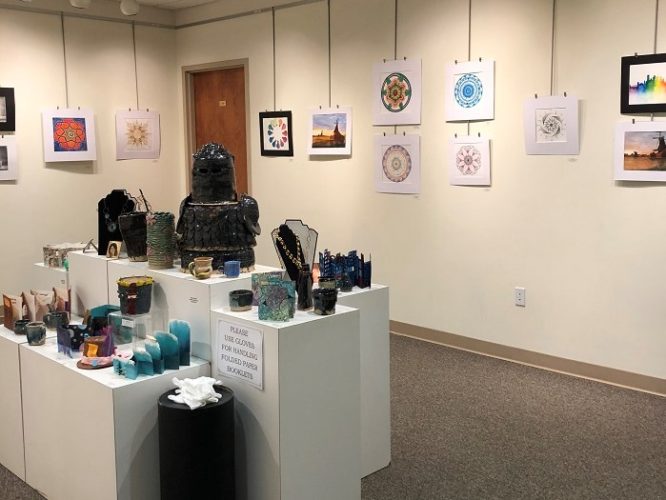 Kaden Hurley - The Yellow Jacket
Kaden Hurley - The Yellow Jacket Every semester, a conglomeration of artwork takes over the Fine Arts Center’s show room. According to the Fine Arts Department Chair, Andrew Heisey, this gallery holds high importance to students of all paths, especially outside of the Fine Arts Department’s majors or minors.
“In those classes, there are a lot of art majors, but most of the students are students getting their [general education] requirements.” Heisey said. “It may be the only time they see their work in that kind of situation. Even in ceramics, where they don’t need to do much to prepare, it looks different. Now it’s on a stand with lights on it; it changes the work.”
The collection displays over 50 students’ artwork while simultaneously representing every art class offered during the Spring 2018 semester, including a new course called book making.
Upon walking into the show room, viewers may be surprised to see a table with white gloves beside the display tables. These gloves are mandatory in order to pick up and examine the books produced by the new class. According to Heisey, this accommodation presented a new challenge for set up.
“This was the first time we’ve had to do that in this gallery,” Heisey said. “It’s very common in other galleries, especially with book-making exhibits, because it’s hard to see a book unless you can open it, but you don’t want to touch the work. Your fingers have oil and things that could damage the pages, and the gloves prevent that.”
Heisey adds that he understands students may be intimidated by the new element, but encourages them to try it out anyway.
“Some of the books just make more sense if you can pick it up and look at it,” said Heisey. “They look great as sculpture objects, but I know some of them, when I looked at them – without any words – there’s a story being told that you can’t quite get if you look at it as a sculpture.”
A story is what initially pulled Kathryn Thompson, sophomore marine biology major and art minor, into the realm of art in the first place.
“I fell in love with art in high school, but I wasn’t sure about making a career out of it; I love it so much that I wanted to continue learning more skills,” Thompson said. “Plus, I knew that if I didn’t do this in college, I probably wouldn’t have made as much time to do art, and this forces me to do it so I’m very glad that I did.”
Thompson’s on-display artwork is a graphite piece entitled, “Brainwash,” which she said is her favorite piece from college so far.
“My midterm project was taking a compound word, and at that point, I had no idea what I wanted,” said Thompson. “I was texting people and looking up compound words, and for some reason, ‘brainwash’ stood out to me. I just had this flow of ideas, and I found pictures of a brain in a tub and thought ‘wow, I really like this one.’”
Not every artist is from the department, though. Senior physical therapy major Cameron Wade decided to select a “fun” elective for senior year: watercolor.
Wade has two pieces hanging adjacent in the art exhibit that demonstrate her watercolor abilities: “City” and “Windmill.”
“[We received] pictures in class of the windmill and cityscape,” Wade said. “We were working on how to use different textures within the painting. A lot of it was drybrush. Some of it, I used the flow of the water. I enjoyed both.”
Wade took the class for an elective credit, but also because of a tradition she looked forward to with her grandmother.
“When I was little, I used to paint and draw with my grandmother,” said Wade. “I was the only female in my family for a while. She taught me how to sew, how to paint and how to bake in the kitchen. I would go over every summer and spend hours with her. I enjoyed spending time with her and learning from her.”
Wade’s experience prompted her to take art classes multiple years in a row, as she says they help keep her relaxed and allow her mind to wander. She also said the skills learned in class have transferred over to her job as a physical therapist.
“It taught me to remain calm when things don’t go as planned,” said Wade. “In art, you think something will look cool, then it doesn’t. It’s like in physical therapy when things pop up. You have to start over or you have to revamp what you originally thought. You’re going to make mistakes, but you can correct it, fix it.”
Heisey, too, said there’s a great benefit for non-majors to invest time in an art course or two besides achieving that general education requirement.
“These classes stretch creativity,” Heisey said, “So many times, we’re used to being given a problem with a set way to answer it. Here, students are given a problem to solve, but there’s not one way to solve it. I always love seeing how a student is going to figure out a solution to a problem, and I’m often surprised by what they come up with.”
